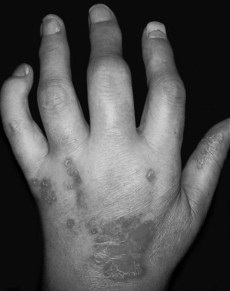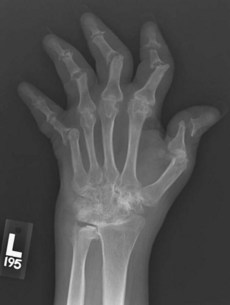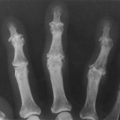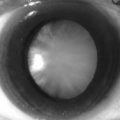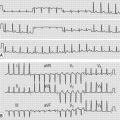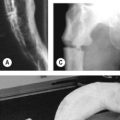129 Psoriatic arthritis
Salient features
Examination
• Tell the examiner that you would like to:
• Comment on the fingers, which are sausage shaped because of tenosynovitis (Fig. 129.1).
Advanced-level questions
What are the patterns of joint involvement seen in psoriasis?
The patterns include (Acta Derm Venereol 1961;41:396–403):
• asymmetrical terminal joint involvement
• symmetrical joint involvement as seen in rheumatoid arthritis
• sacroiliitis: this differs from ankylosing spondylitis, most notably in that the syndesmophytes tend to arise from the lateral and anterior surfaces of the vertebral bodies and not at the margins of the bodies
• arthritis mutilans: complicated by the ‘telescoping’ of digits.
What are the radiological features of psoriatic arthritis?
What do you know about pathogenesis of psoriasis and therapy to mitigate it?
T cell activation. Inhibition by drugs of molecules involved in the formation of the immunologic synapse.
Pathogenic T cells. Depletion is achieved by targeting molecules expressed specifically by activated T cells, such as the high-affinity interleukin-2 receptor or CD4.
Leukocyte recruitment to the inflamed skin. Inhibited by blocking key adhesion molecules such as selectins or certain integrins, e.g. using efalizumab, a monoclonal antibody that interferes with adhesion mediated by leukocyte-function-associated antigen 1 (LFA-1)].
Release of inflammatory cytokines (e.g. TNF-α). Targeted by several biologic agents, the monoclonal antibodies infliximab and adalimumab, and the fusion proteins etanercept and onercept
Predominance of helper T cells (Th) type 1. Induction of shift in immune balance to a milieu weighted with Th2 cells, thus alleviating psoriasis, e.g. using interleukin-10 and interleukin-4.

